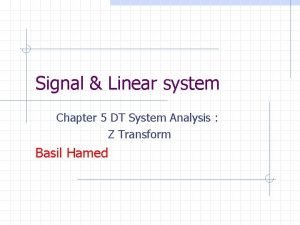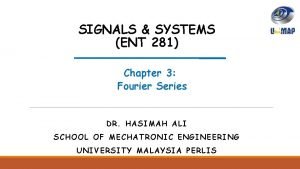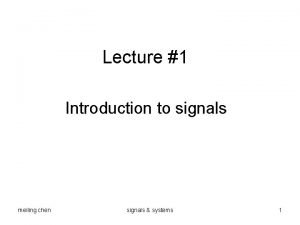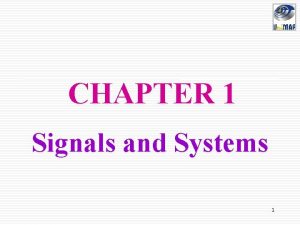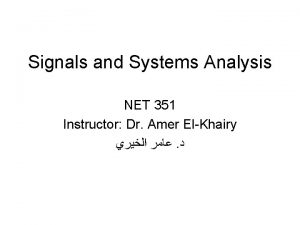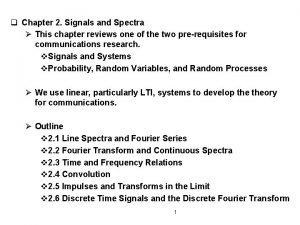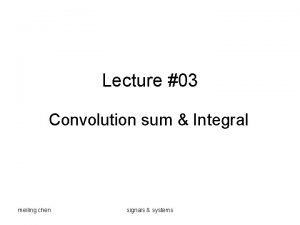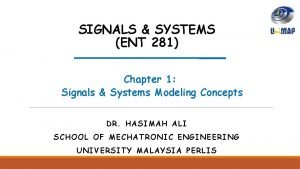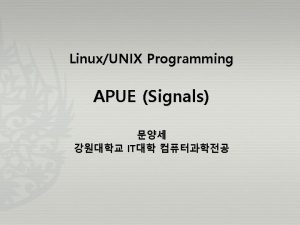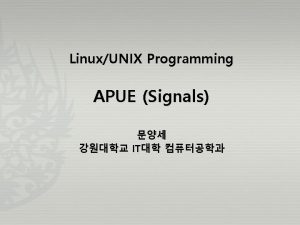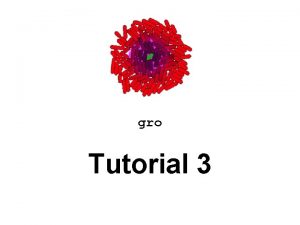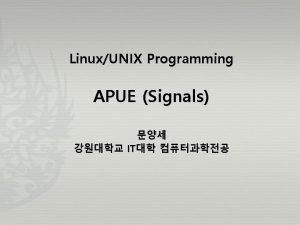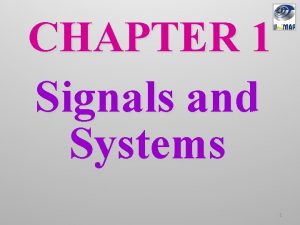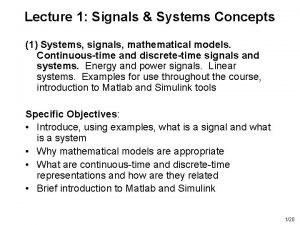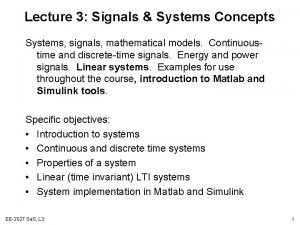CHAPTER 1 SIGNALS AND SYSTEMS Signals are functions




![DT Signals x[n], n—integer, time varies discretely Examples of DT signals in nature: —DNA DT Signals x[n], n—integer, time varies discretely Examples of DT signals in nature: —DNA](https://slidetodoc.com/presentation_image_h2/b90cdba36412eec8ddf5e74c1736104b/image-5.jpg)





- Slides: 10

CHAPTER 1 SIGNALS AND SYSTEMS

Signals are functions of independent variables that carry information. For example: Electrical signals ---voltages and currents in a circuit • Acoustic signals ---audio or speech signals (analog or digital) Video signals ---intensity variations in an image (e. g. a CAT scan) Biological signals ---sequence of bases in a gene

THE INDEPENDENT VARIABLES Can be continuous Trajectory of a space shuttle � Mass density in a cross-section of a brain • Can be discrete � DNA base sequence � Digital image pixels � Can be 1 -D, 2 -D, • • • N-D For this course: Focus on a single (1 -D) independent variable which we call“time”. Continuous-Time (CT) signals: x(t), t—continuous values. Discrete-Time (DT) signals: x[n], n—integer values only

CT Signals Most of the signals in the physical world are CT signals—E. g. voltage & current, pressure, temperature, velocity, etc.
![DT Signals xn ninteger time varies discretely Examples of DT signals in nature DNA DT Signals x[n], n—integer, time varies discretely Examples of DT signals in nature: —DNA](https://slidetodoc.com/presentation_image_h2/b90cdba36412eec8ddf5e74c1736104b/image-5.jpg)
DT Signals x[n], n—integer, time varies discretely Examples of DT signals in nature: —DNA base sequence—Population of the nth generation of certain species •

Many human-made DT Signals Ex. #1 Weekly Dow. Jonesindustrial average Ex. #2 digital image Courtesy of Jason Oppenheim. Used with permission. Why DT? —Can be processed by modern digital computers and digitalsignal processors (DSPs).

SYSTEMS For the most part, our view of systems will be from an input-output perspective: A system responds to applied input signals, and its response is described in terms of one or more output signals x(t) x[n] CT system DT system y(t) y[n]

EXAMPLES OF SYSTEMS An RLC circuit x(t) + - + y(t) Dynamics of an aircraft or space vehicle An algorithm for analyzing financial and economic factors to predict bond prices An algorithm for post-flight analysis of a space launch An edge detection algorithm for medical images

SYSTEM INTERCONNECTIOINS An important concept is that of interconnecting systems � To build more complex systems by interconnecting simpler subsystems � To modify response of a system

Signal flow (Block) diagram Classcade Parallel Feedback + +
 Mikael ferm
Mikael ferm Signals and systems oppenheim solutions chapter 5
Signals and systems oppenheim solutions chapter 5 Animals and human language chapter 2
Animals and human language chapter 2 Arbitrariness in human language and animal language
Arbitrariness in human language and animal language Communicative signals and informative signals
Communicative signals and informative signals Parseval identity
Parseval identity Chen
Chen Precedence rule in signals and systems
Precedence rule in signals and systems Convolution sum in signals and systems
Convolution sum in signals and systems Pulse train fourier transform
Pulse train fourier transform Integral convolution
Integral convolution

